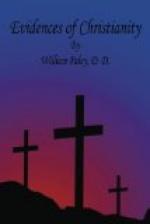III. The miracles related to have been wrought at the tomb of the abbe Paris admit in general of this solution. The patients who frequented the tomb were so affected by their devotion, their expectation, the place, the solemnity, and, above all, by the sympathy of the surrounding multitude, that many of them were thrown into violent convulsions, which convulsions, in certain instances, produced a removal of disorder, depending upon obstruction. We shall, at this day, have the less difficulty in admitting the above account, because it is the very same thing as hath lately been experienced in the operations of animal magnetism: and the report of the French physicians upon that mysterious remedy is very applicable to the present consideration, viz. that the pretenders to the art, by working upon the imaginations of their patients, were frequently able to produce convulsions; that convulsions so produced are amongst the most powerful, but, at the same time, most uncertain and unmanageable applications to the human frame which can be employed.
Circumstances which indicate this explication, in the case of the Parisian miracles, are the following:
1. They were tentative. Out of many thousand sick, infirm, and diseased persons who resorted to the tomb, the professed history of the miracles contains only nine cures.
2. The convulsions at the tomb are admitted.
3. The diseases were, for the most part, of that sort which depends upon inaction and obstruction, as dropsies, palsies, and some tumours.
4. The cures were gradual; some patients attending many days, some several weeks, and some several months.
5. The cures were many of them incomplete.
6. Others were temporary. (The reader will find these particulars verified in the detail, by the accurate inquiries of the present bishop of Sarum, in his Criterion of Miracles, p. 132, et seq.)
So that all the wonder we are called upon to account for is, that out of an almost innumerable multitude which resorted to the tomb for the cure of their complaints, and many of whom were there agitated by strong convulsions, a very small proportion experienced a beneficial change in their constitution, especially in the action of the nerves and glands.
Some of the cases alleged do not require that we should have recourse to this solution. The first case in the catalogue is scarcely distinguishable from the progress of a natural recovery. It was that of a young man who laboured under an inflammation of one eye, and had lost the sight of the other. The inflamed eye was relieved, but the blindness of the other remained. The inflammation had before been abated by medicine; and the young man, at the time of his attendance at the tomb, was using a lotion of laudanum. And, what is a still more material part of the case, the inflammation, after some interval, returned. Another case was that of a young man




